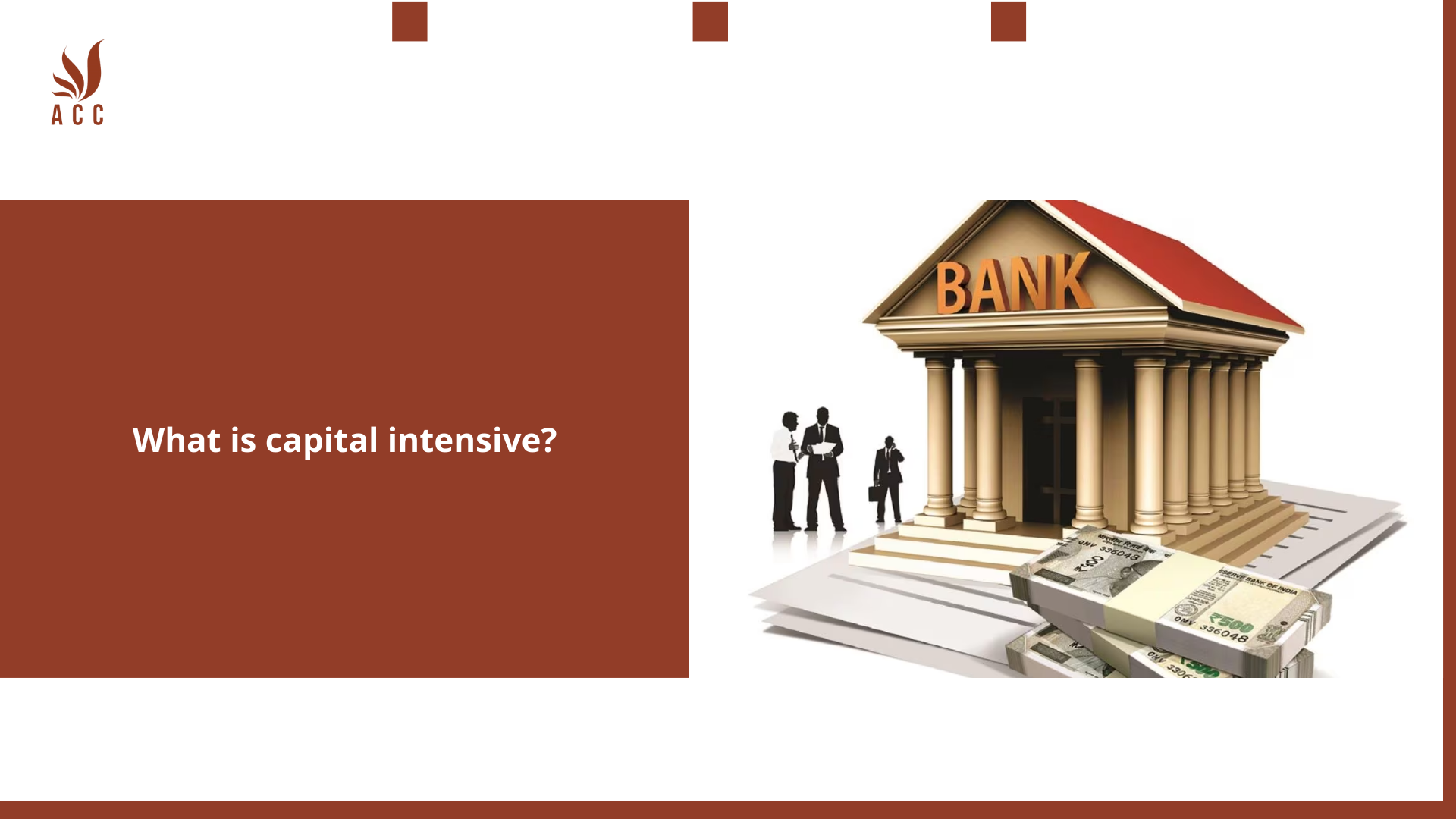
1. What is capital intensive?
In the realm of economics and business, the term "capital intensive" holds a significant place. It refers to those specific business processes and industries that demand substantial financial investments to create a product or service. Such endeavors often rely heavily on fixed assets, including properties, plants, and equipment (commonly abbreviated as PP&E). As a defining feature, companies within capital-intensive industries typically grapple with high depreciation levels, and this article will delve into the various facets of such industries.
2. Unraveling the Essence of Capital Intensive
Capital-intensive industries, by their nature, exhibit a striking characteristic—high operating leverage. This measure denotes the proportion of fixed costs to variable costs. Consequently, these industries necessitate a substantial volume of production to generate a satisfactory return on investment. This also means that even minor fluctuations in sales figures can result in significant shifts in profits and the overall return on invested capital.
The elevated operating leverage makes capital-intensive industries considerably more susceptible to economic downturns compared to their labor-intensive counterparts. The reason is simple: they are still obliged to cover fixed costs, which include overhead expenses related to the facilities housing their equipment and the ongoing depreciation of said equipment. These financial obligations persist, irrespective of the industry's health and vitality.
3. Examples of Capital-Intensive Industries
Several sectors fall under the banner of capital-intensive industries, each characterized by massive capital requirements. Prominent examples include:
Automobile Manufacturing
- Demand substantial financial resources to build and maintain manufacturing facilities.
- Extensive investment in production equipment and assembly lines.
Oil Production and Refining
- Huge expenditures for drilling, refineries, and oil rigs.
- Maintenance and safety measures for complex machinery.
Steel Production
- Heavy investments in blast furnaces, rolling mills, and infrastructure.
- Continuous upgrades and maintenance of steel-making equipment.
Telecommunications
- Infrastructure expansion with significant outlays for network infrastructure and data centers.
- Maintenance of a vast network of communication equipment.
Transportation Sectors (e.g., Railways and Airlines)
- Extensive capital investment in railway tracks, airplanes, and terminals.
- Regular maintenance and safety measures for transportation vehicles.
These industries encompass a wide range of products and services that significantly impact the global economy. Their capital-intensive nature sets them apart in terms of the colossal financial backing required to operate effectively.
4. Quantifying Capital Intensity
In the realm of finance, measuring capital intensity is essential for gaining insights into a company's operational dynamics. This can be accomplished by determining how many assets are necessary to produce one dollar in sales. The formula is simple: total assets divided by sales. This calculation represents the inverse of the asset turnover ratio, a vital indicator of how efficiently a company leverages its assets to generate revenue.
Another method to evaluate a company's capital intensity is by comparing capital expenses to labor expenses. For instance:
- If a company allocates $100,000 to capital expenditures and $30,000 to labor costs, it signals a capital-intensive operation.
- Conversely, if a company invests $300,000 in labor and only $10,000 in capital expenses, it leans toward a more service- or labor-oriented model.
5. Key Takeaways for Capital Intensity
Understanding capital intensity goes beyond the numbers and ratios; it has several critical implications for businesses:
- Capital intensity is gauged by analyzing capital and labor expenses.
- Capital-intensive firms commonly wrestle with high depreciation costs and substantial operating leverage.
- The capital intensity ratio is derived by dividing total assets by sales.
6. The Impact of Capital Intensity on Earnings
Invariably, capital-intensive firms make extensive use of financial leverage, often using their plant and equipment as collateral. However, treading down this path with high operating leverage and financial leverage can be perilous if sales take an unexpected downturn.
Since capital-intensive industries often grapple with high depreciation costs, analysts covering such sectors typically include depreciation when assessing net income. This is achieved through a crucial metric called earnings before interest, taxes, depreciation, and amortization (EBITDA). Using EBITDA, instead of net income, offers a more accurate means of comparing the performance of companies within the same industry, given their shared capital-intensive characteristics.
In conclusion, capital-intensive industries are the bedrock of the modern economy, underpinning vital sectors such as manufacturing, energy, and transportation. Their financial demands are substantial, and their operational intricacies are unique. It is crucial for businesses and investors to comprehend the intricacies of capital intensity to thrive in these dynamic environments.
7. Why should professionals use ACC Law Firm's capital Service?
-
Expertise in Legal Matters: ACC Law Firm specializes in legal services, providing professionals with access to experienced attorneys who can offer valuable legal guidance. Whether it's contract negotiations, intellectual property issues, employment matters, or any other legal concern, their expertise can be invaluable.
-
Tailored Legal Solutions: ACC Law Firm understands that every professional's needs are unique. They can customize their legal services to address the specific challenges and opportunities faced by professionals in different fields.
-
Risk Mitigation: Legal issues can pose significant risks to professionals and their businesses. ACC Law Firm can help identify and mitigate these risks, reducing the potential for costly legal disputes or compliance issues.
-
Resource Optimization: Professionals can save time and resources by outsourcing their legal needs to ACC Law Firm. This allows them to focus on their core competencies and business objectives, while leaving legal matters in the hands of professionals.
-
Access to a Network: ACC Law Firm may have a network of legal experts and professionals in various fields, which can be beneficial for clients seeking connections and advice beyond just legal services.
Q&A
Question 1: What does it mean for a business to be "capital intensive"?
Answer 1: A capital-intensive business is one that requires significant investments in physical assets, such as machinery, equipment, infrastructure, and technology, to operate efficiently. These businesses often have high initial capital requirements and ongoing maintenance expenses.
Question 2: How does a capital-intensive business differ from a labor-intensive one?
Answer 2: A capital-intensive business relies more on machines, technology, and equipment to perform tasks and requires a substantial upfront investment in these assets. In contrast, a labor-intensive business places a greater emphasis on human resources, with a higher proportion of costs going toward labor wages and benefits.
Question 3: What are some advantages of being a capital-intensive business?
Answer 3: Advantages of capital-intensive businesses include increased production efficiency, lower labor costs, consistent product quality, reduced reliance on human skill variations, and the potential for economies of scale, which can lead to higher profit margins in the long run.
Question 4: What are the potential challenges or drawbacks associated with being capital-intensive?
Answer 4: Challenges of capital-intensive businesses include high initial capital requirements, the need for regular equipment maintenance and upgrades, susceptibility to economic downturns that reduce demand, and the risk of depreciation as assets age. Additionally, these businesses may face difficulty adapting to rapidly changing market conditions.
Nội dung bài viết:






Bình luận